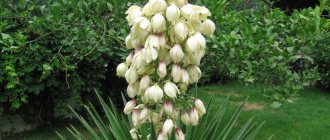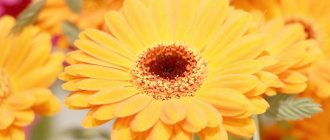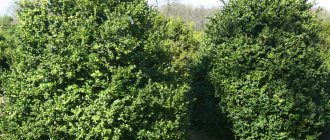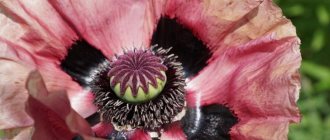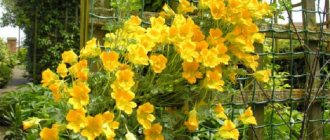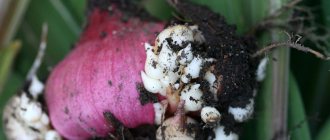A spectacular tropical plant - garden yucca - can decorate your garden plot. It is very exotic and will look spectacular in any garden.
Nowadays, yucca has received well-deserved recognition among amateur gardeners. We will try to consider issues related to its proper fit and subsequent care.
Description and photo of garden yucca
Yucca garden is a perennial shrub. Its foliage is a kind of rosette; inside it the leaves grow in a spiral shape. They are usually green or gray in color and can grow up to 25-100 cm.
In the very center there is a peduncle with white flowers. Over the course of one season, approximately two hundred bell-shaped flowers bloom on the inflorescences, reaching approximately seven centimeters in length and five centimeters in width. After flowering, the seed fruit appears.general information
Yucca belongs to the agave family and grows naturally in the tropics. There are tree-like and bushy forms of completely different types. Some are more like palm trees with a trunk and a characteristic top, while others form basal rosettes.
Yucca has long, pointed leaves in all shades of green, gray and bluish. They can reach up to 1 m in length, but the width rarely exceeds 7 cm. Therefore, yucca is often called a sword-shaped or dagger-shaped plant.
Yucca is capable of blooming with large bells collected in an erect panicle. The most common buds are white, yellow and cream. The height of the peduncle reaches 2 m, and it looks impressive. Sugar is made from yucca juice, and strong threads are made from fibers.
Photo: vodakanazer.ru
Types of garden yucca
Two types of yucca are suitable for planting in open ground:
- Gray yucca is a fairly tall plant, not demanding on the soil, and can withstand dry and frosty weather. However, it is extremely sensitive to abundant moisture and watering.
- Yucca filamentosa is a tree-like bush, its sword-shaped leaves reach a length of up to 70 cm and a width of 3 to 10 cm. It is very unpretentious and can withstand air temperatures down to -20C without damage.
Information about the plant
The genus Yucca is represented by more than 30 species of evergreen tree-like plants. Their homeland is North America (southern USA, Mexico and Central America). Many species are cultivated in Europe and the CIS countries (Belarus, Kazakhstan, Russia, Ukraine).
Yucca filamentosa is used to make paper and rope, and its fibers complement cotton denim fabric for greater wear resistance.
Yucca schidigera extract is included in many cosmetic products: cleansing powders, shaving creams, intimate hygiene and after hair removal creams, anti-dandruff shampoos and others.
The plant is also used to produce detergents and beer foam in the United States. In addition, it is used in veterinary medicine for the treatment of arthritis, as a food additive for bird and animal feed, including domestic cats and dogs.
Yucca garden: planting and care
Before planting on the site, the yucca must be hardened off. For this purpose, it should be placed outside for several hours every day. The hardening hours are extended every day, with the result that after fourteen days the plant will be ready for planting.
Yucca is light-loving; illuminated areas on hills are ideal for it.
Landing Features
Young bushes need small holes, however, further growth should be taken into account. A three-year-old yucca needs a hole with a girth of 70 to 100 cm. The root is buried approximately 40-50 cm.
The best time to prepare the soil for planting is in the fall. Clay-stony, sandy, calcareous soils and black soil are suitable for yucca. They do not tolerate excess moisture well, therefore, it is better to plant them as far as possible from groundwater. The bottom of the hole can be sprinkled with gravel, sand or ash.
After this, the bush is carefully planted, sprinkling the roots with soil. It is better to work with gloves to avoid cuts on your hands. Water not too much, regularly, using water at room temperature.
Spring is best for planting; the air temperature at the time of planting should not fall below +10C at night.
Reproduction
Yucca propagates vegetatively (parts of the trunk, cuttings, shoots) and seeds, the first option is simpler.
Cuttings
If an apical cutting is used for propagation, it should not be too long (up to 15 cm). A small piece of the top is cut off with a sharp knife, the cut is treated with activated carbon powder, excess foliage is removed, the cutting is dried in the shade in the fresh air for about 2 hours, treated with a growth stimulator, planted in a moist substrate (a mixture of humus with perlite and sand), and covered with film. Before rooting, daily ventilation and spraying are required.
The substrate can be replaced with boiled water to which activated carbon has been added. At a temperature of 24-26oC, the water is changed every 3 days. The plant is planted into the substrate after sufficient roots have formed.
But experienced gardeners do not recommend using water. The roots are weak and the risk of damage during planting increases.
From the stems, cuttings with viable buds are obtained by cutting them at the places where the leaves are attached. Only the substrate is used for rooting. The cuttings are placed vertically or horizontally in it. In the second option, half is buried and the ends are sprinkled with soil. This allows you to get multiple plants.
Contents of vertical cuttings:
- greenhouse conditions are created using cans or film;
- the substrate should always be moist;
- room temperature 20-24°C (can be heated from below).
Lateral shoots are not formed in all varieties. They are the most convenient for reproduction. Shoots separated from the mother plant in the spring take root faster. The rosette is cut off, the cut is treated with activated carbon powder, and the shoot is planted in a moist soil mixture. The rooting rules are the same as for stem cuttings rooted vertically.
Seeds
The bags, which are available in shopping centers, contain no more than 5 glossy black seeds. Before germination, the peel must be damaged (it is very hard), and moist, loose soil is prepared from turf soil and sand.
The seeds are buried half a centimeter, the container is placed in a warm place (from +25°C) and covered with film. Daily ventilation is required. Sprouts appear within a month. The seedlings can be transplanted into separate containers with a diameter corresponding to the size of the roots after the appearance of 2 true leaves.
Watering and subcortex
Yucca does not require special conditions and care. It should be watered regularly, but infrequently, after the top layer of soil has dried. Sometimes you can spray the leaves with water, especially if they dry out.
It is best to carry out this procedure in the evening or early morning.
During growth, the plant needs to be fed twice with minerals. First - in May, at the beginning of the growing season, then - immediately after flowering ends.
Yucca garden diseases
Yucca gets sick quite rarely. Sometimes plants experience yellowing and wilting of leaves. If this happens to the lower leaves of the plant, there is no need to worry - they tend to wither and fall off over time, this is a natural process.
Also, yellowing of the leaves occurs in cases where the plant is exposed to a draft or is frozen.
Clarkia graceful - varieties and types, care and planting, diseases + 78 photos- Irises - description of the species, cultivation, reproduction + 102 photos
Campsis - planting, care, location rules, watering, types of reproduction (67 photos + video)
Transfer
With prolonged growth, the yucca grows and requires replanting, but it must be remembered that frequent replanting is harmful to the plant. Experienced gardeners in such cases recommend:
- Transplantation is carried out either in spring or at the end of summer. You need to remove the plant from the ground carefully, without damaging the roots. The emerging shoots are separated and planted separately.
- The new landing site should not be fundamentally different from the previous one.
- The area for planting yucca should be as light as possible.
- The transplanted plant needs to be fed after fourteen days. Flowering should be expected after a year from the moment of transplantation.
In landscape design
If yucca grows in the garden, then the surrounding landscape immediately takes on a Mediterranean hue.
It will look great even in the driest areas and territories. It is the appearance, reminiscent of a palm tree, that gives the garden plot a special southern atmosphere, especially if other southern representatives, such as garden hibiscus, are located nearby. Even if yucca grows as a single plant, it is able to captivate with its appearance during the flowering period and at this moment become the brightest and most colorful spot on the garden plot.
Some types are used in the design of verandas, staircases and other architectural structures. Such options do not require winter shelters or special rooms for the winter season.
Insulation of garden yucca
A logical question often arises - how to properly insulate a garden yucca for the winter and is it necessary to do it?
Filamentous and glaucous yucca are frost-resistant, being quite painless in the face of a short drop in air temperature. In regions with cold winters, garden yucca needs to be insulated.
There are several methods of insulation:
Collect yucca leaves and tie them with twine. To prevent the ground from freezing, place the lower leaves on the ground. The soil near the bush is covered with dried leaves, and boards are laid on top to prevent it from being blown away by the wind.
After this, the bush is covered with polyethylene, the lower part of the trunk is sprinkled with soil.
Bacopa - description of the species, cultivation, care, reproduction + 74 photosGarden hibiscus - types, description, planting, care and propagation + 69 photos
- Celosia - growing from seeds and seedlings, planting in the ground and care rules + 80 photos
There is another method of insulation - using a large wooden box covered with dense material, roofing felt or polystyrene foam will do. Then the insulating structure is covered with dried leaves, after which it is covered with spruce branches or straw, and a film can be placed on top.
It is recommended to carry out insulation in late autumn, at the end of October-November, and it is worth removing the protection only when any threat of cold weather and frost has passed.
Garden yucca will help create an unusual exotic corner on your site. This beautiful tropical plant is extremely unpretentious. With proper care, yucca will delight you for a very long time.
How to cover for the winter
Is it necessary to dig up yucca before frost?
It is enough to insulate the plant before the cold season sets in. Plants tolerate short-term cold in spring and autumn quite easily. It is important that the fallen snow melts quickly. Frost-resistant specimens perceive such temporary inconveniences especially easily. But real long frosts during a snowless winter are certain death for garden yucca.
The yuca foliage is wrapped with twine to gather it together and the plant is covered with a box, on top of which spruce branches or fallen leaves are laid. This composition is secured by a covering material wrapped with tape. In such a shelter, the yucca will easily overwinter without fear of any frost, especially when a large layer of fluffy snow falls on top.
In the spring, when the temperature becomes stable, it is time to free the plant from its winter shelter. Do not delay this for too long, otherwise it may lead to the appearance of mold.
